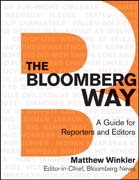
The definitive guide to reporting and editing the story of money As more and more people are affected by the actions of Wall Street and the federal government, financial reporting has become even more important. Bloomberg's reputation for fast, accurate reporting is widely known and respected among not only journalists, but the general public. The Bloomberg Way, an internal Bloomberg publication for nearly twenty years, reflects the new realities of journalism where speed is paramount, the impact of news is instantaneous, and the lines between objectivity and opinion are increasingly blurred. The Bloomberg Way is the most thorough and comprehensive guide to reporting and editing the story of money. Outlining the central principles of Bloomberg News, this book is an essential guide for both journalism professionals and students, and will put any writer in a better position to report with accuracy and honesty. Details the basic tenets of solid reporting, the five F's: Factual, First, Fastest, Final, and Future Discusses the essentials of writing a good lead and offers insightson the proper use of voice Addresses how to keep opinion and speculation out of your writing and how to organize storylines when preparing for breaking news on anything from an earnings release to a market crash The Bloomberg Way is the most important writer's resource of one of the largest news organizations in the world. It informs as it instructs, with coverage of essential topics ranging from how to conduct effective interviews to the importance of accuracy and integrity of news gathers and reporters. ÍNDICE: Introduction. Acknowledgments. Chapter 1: The Bloomberg Way. Chapter 2: Principles. Chapter 3: The Five Fs. Chapter 4: The Four-Paragraph Lead. Headlines. Leads. Size and Scope. Reinforcing the Lead. Quotations. Details. Nut Paragraphs. To Be Sure. Chapter 5: Five Easy Pieces. Chapter 6: Show Don't Tell. Characterizations. Assertions. Anecdotes. Chapter 7: Writing Well Matters. Precision and Brevity. Jargon. Cliches. Word Echoes. Tense and Voice. StoryLength. Chapter 8: Headlines. Chapter 9: Preparation. Collecting String. Top 10s. Curtain-Raisers. Templates. Chapter 10: Covering News. Breaking News. News Releases. Rumor and Speculation. Media Summaries. Complete Coverage. Chapter11: Ethics. Fairness. Public Responsibilities. Endorsements. Plagiarism. Working for Bloomberg. Transparency. Covering Bloomberg. Accuracy. Corrections. Sending Corrections. Sourcing. Attribution. Anonymous Sources. Conduct. Libel. Red Flags. Avoiding Libel. Chapter 12: Enterprise. Idea to Story. Preparing a Pitch. Types of Enterprise. Reporting. A Model of Reporting. Organizing the Story. The Rest of the Story. Chapter 13: Chart of the Day. Chapter 14: How We Work. Reporters. Interviewing. Accuracy. Editors. Editing Checklist. Team Leaders. Bureau Chiefs. Chapter 15: Markets. How to Cover Markets. Four Pillars of Market Coverage. Writing Market Leads. Keeping Market Stories Fresh. Weekly Perspective. Technical Analysis. Stocks. Stock Market Leads. Themes for Stocks. Bonds. Themes for Government Bonds. Government Bond Leads. Corporate Bonds. Themes for Corporate Bonds. Swaps. Money Markets. Currencies. Covering Currency Markets. Themes for Currencies. Commodities. Themes for Commodities. Chapter 16: Companies. Market Perspective. Shares Up and Down. Debt. Credit-Default Swaps. Earnings. Mergers and Acquisitions. Valuation. Value Comparisons. Financing. Initial Public Offerings. Bond Sales. Repurchases and Dividends. Chapter 17:Economies. Covering Economies. Chapter 18: Politics and Policy. Follow the Money. Financing Government. Opinion Polls. Chapter 19: People. Chapter 20: Stories. Story Headlines. Style and Punctuation. Stand-Alone Headlines. Subheadlines. Trashlines. Datelines. Bylines. Links. Coding. Updates. Summaries. Fairness. Voices. Sending to Newspapers. AV. Chapter 21: Questions. Stock Activity. Equity and Debt Sales. Loans and Lines of Credit. Management Changes. Stock Buybacks. Dividend Payments. Interest and Principal Payments. Mergers and Acquisitions. Bankruptcies. Litigation. Regulation. Products and Services. Property, Plant and Equipment. Contracts and Agreements. Chapter 22: Grammar. Agreement of Subject and Verb. Commas. Hyphens. Only. That. Which. Has and Have. Who andWhom. Chapter 23: Words and Terms. Names.
- ISBN: 978-1-118-03017-2
- Editorial: John Wiley & Sons
- Encuadernacion: Rústica
- Páginas: 400
- Fecha Publicación: 19/10/2011
- Nº Volúmenes: 1
- Idioma: Inglés
